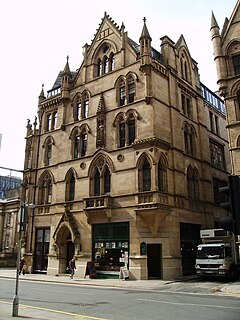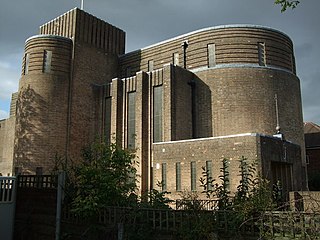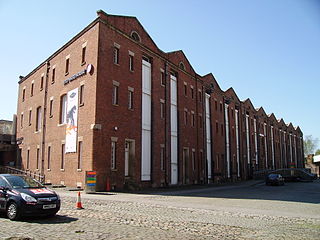
Wythenshawe is an area of south Manchester, England.

The Edgar Wood Centre is a former Church of Christ, Scientist building in Fallowfield, Manchester, England. The church was designed by Edgar Wood in 1903. Nikolaus Pevsner considered it "the only religious building in Lancashire that would be indispensable in a survey of twentieth century church design in all England." It is a Grade I listed building and has been on the Heritage at Risk Register published by Historic England.

Hugh Segar "Sam" Scorer FRIBA FRSA was an architect who worked in Lincoln, England and was a leading pioneer in the development of hyperbolic paraboloid roof structures using concrete. He also was involved in architectural conservation and research into the work of local 19th-century architects, as well as founding an art gallery in Lincoln, now known as the Sam Scorer Gallery. He held the rare distinction of having two of his buildings listed within his lifetime.

The Peacock Mausoleum is a Victorian Gothic memorial to Richard Peacock (1820–1889), engineer and Liberal MP for Manchester, and to his son, Joseph Peacock. It is situated in the cemetery of Brookfield Unitarian Church, Gorton, Manchester. The mausoleum was designed by the prolific Manchester architect Thomas Worthington. It was listed Grade II* on the National Heritage List for England on 3 October 1974.

India House in Whitworth Street, Manchester, England, is a packing and shipping warehouse built in 1906 for Lloyd's Packing Warehouses Limited, which had, by merger, become the dominant commercial packing company in early-20th century Manchester. It is in the favoured Edwardian Baroque style and is steel-framed, with cladding of buff terracotta and red brick with buff terracotta dressings. It is a Grade II* listed building as of 3 October 1974.

The Tootal, Broadhurst and Lee Building at No. 56 Oxford Street, in Manchester, England, is a late Victorian warehouse and office block built in a neo-Baroque style for Tootal Broadhurst Lee, a firm of textile manufacturers.

Royal Mill, which is located on the corner of Redhill Street and Henry Street, Ancoats, in Manchester, England, is an early-twentieth-century cotton mill, one of the last of "an internationally important group of cotton-spinning mills" sited in East Manchester. Royal Mill was constructed in 1912 on part of the site of the earlier McConnel & Kennedy mills, established in 1798. It was originally called New Old Mill and was renamed following a royal visit by King George VI and Queen Elizabeth in 1942. A plaque commemorates the occasion. The Ancoats mills collectively comprise "the best and most-complete surviving examples of early large-scale factories concentrated in one area".

Lawrence Buildings in Mount Street, Manchester, England, is a Victorian office block constructed for the Inland Revenue in 1874–6 by Pennington and Bridgen in the Gothic Revival style. It is a Grade II* listed building as of 3 October 1974.

The Church of St Michael and All Angels, Orton Road, Lawton Moor, Northenden, Manchester, is an Anglican church of 1935-7 by N. F.Cachemaille-Day. Pevsner describes the church as "sensational for its country and its time". The church has been listed Grade II* on the National Heritage List for England since 16 January 1981.

The Church of St Mary, Upper Moss Lane, Hulme, Manchester, is a Gothic Revival former church by J. S. Crowther built in 1853–58. It was designated a Grade II* listed building on 3 October 1974.

The Church of St Nicholas, Kingsway, Burnage, Manchester, is a Modernist church of 1930–2 by N. F. Cachemaille-Day, Lander and Welch. It was enlarged in 1964 with a bay on the west side, also by Cachemaille-Day. Pevsner describes the church as "a milestone in the history of church architecture in England". The church was designated a Grade II* listed building on 10 October 1980.

The 1830 warehouse, Liverpool Road, Manchester, is a 19th-century warehouse that forms part of the Liverpool Road railway station complex. It was built in five months between April and September 1830, "almost certainly [to the designs of] the Liverpool architect Thomas Haigh". The heritage listing report attributes the work to George Stephenson and his son, Robert. It has been listed Grade I on the National Heritage List for England since May 1973.

St Thomas' Church is in Eskrick Street, Halliwell, a residential area of Bolton, Greater Manchester, England. It is an active Anglican parish church in the deanery of Bolton, the archdeaconry of Bolton, and the diocese of Manchester. Its benefice is united with those of five other local churches to form the Benefice of West Bolton. The church is recorded in the National Heritage List for England as a designated Grade II* listed building.

Blackfriars Bridge is a stone arch bridge in Greater Manchester, England. Completed in 1820, it crosses the River Irwell, connecting Salford to Manchester.

Kearsley Mill is a 240,000 sq ft (22,000 m2), late period cotton mill located in the small village of Prestolee in Kearsley, Greater Manchester, part of the historic county of Lancashire. A near complete example of Edwardian mill architecture, the building now functions as headquarters for a number of businesses and is still used in the continued manufacturing and distribution of textiles by Richard Haworth Ltd Est (1876), part of the Ruia Group. The mill is a Grade II listed building.
Sharston Hall was a manor house built in Sharston, an area of Wythenshawe, Manchester, England, in 1701. A three-storey building with Victorian additions, it was purchased by Thomas Worthington, an early umbrella tycoon, and occupied by the Worthington family until 1856, when the last male heir died. The hall was occupied by the Henriques family in the 1920s, but following their death in a motor accident in 1932 the house was converted into flats. Manchester Corporation purchased the hall in 1926. During the Second World War it was leased by the local watch committee for use by the police, civil defence and fire services.
Manchester is a city in Northwest England. The M22 postcode area of the city includes parts of the suburbs of Northenden and Wythenshawe. This postcode area contains 15 listed buildings that are recorded in the National Heritage List for England. Of these, three are listed at Grade II*, the middle of the three grades, and the others are at Grade II, the lowest grade. The area is largely residential and most of the listed buildings are houses and churches and associated structures. The other listed buildings include a bridge, a war memorial, and a former bus depot.
Manchester is a city in Northwest England. The M23 postcode area of the city includes parts of the suburbs of Wythenshawe and Northenden. The postcode area contains eleven listed buildings that are recorded in the National Heritage List for England. Of these, one is listed at Grade I, the highest of the three grades, two are at Grade II*, the middle grade, and the others are at Grade II, the lowest grade. The area is almost completely residential, and the listed buildings include two former manor houses and associated structures, a former farm and outbuildings, a house, a church, and a vicarage.
Manchester is a city in Northwest England. The M60 postcode area of the city is termed a non-geographic postcode area - that is, it does not correspond with a specific area. Buildings given an M60 postcode were historically very large receivers of mail, and were usually located in the City Centre, although Great Universal Stores also used an M60 code. The postcode was created for internal Royal Mail reasons - It allowed for large amounts of mail to by-pass the sorting processes within the city centre quickly and efficiently. The postcode contains 13 listed buildings that are recorded in the National Heritage List for England. Of these, one is listed at Grade I, the highest of the three grades, one is at Grade II*, the middle grade, and the others are at Grade II, the lowest grade. The area to the northwest contains HM Prison Manchester, and four structures associated with it are listed. The other listed buildings include two structures associated with Liverpool Road railway station, office buildings, a hotel, a departmental store, and a pair of bollards.
Manchester is a city in Northwest England. The M8 postcode area is to the north of the city centre, and contains the districts of Cheetham Hill and Crumpsall. This postcode area contains 20 listed buildings that are recorded in the National Heritage List for England. Of these, two are listed at Grade II*, the middle of the three grades, and the others are at Grade II, the lowest grade. The area is residential, and the listed buildings include churches and associated structures, houses, former civic buildings, two museums, a bandstand, a park shelter, a former billiard hall, and a war memorial.




















